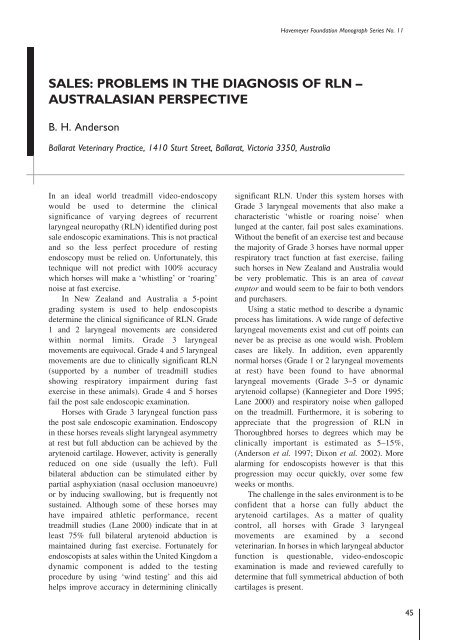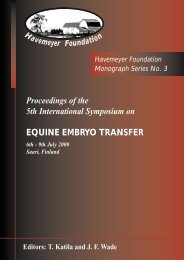Proceedings of a Workshop on - The Havemeyer Foundation
Proceedings of a Workshop on - The Havemeyer Foundation
Proceedings of a Workshop on - The Havemeyer Foundation
You also want an ePaper? Increase the reach of your titles
YUMPU automatically turns print PDFs into web optimized ePapers that Google loves.
<strong>Havemeyer</strong> Foundati<strong>on</strong> M<strong>on</strong>ograph Series No. 11<br />
SALES: PROBLEMS IN THE DIAGNOSIS OF RLN –<br />
AUSTRALASIAN PERSPECTIVE<br />
B. H. Anders<strong>on</strong><br />
Ballarat Veterinary Practice, 1410 Sturt Street, Ballarat, Victoria 3350, Australia<br />
In an ideal world treadmill video-endoscopy<br />
would be used to determine the clinical<br />
significance <str<strong>on</strong>g>of</str<strong>on</strong>g> varying degrees <str<strong>on</strong>g>of</str<strong>on</strong>g> recurrent<br />
laryngeal neuropathy (RLN) identified during post<br />
sale endoscopic examinati<strong>on</strong>s. This is not practical<br />
and so the less perfect procedure <str<strong>on</strong>g>of</str<strong>on</strong>g> resting<br />
endoscopy must be relied <strong>on</strong>. Unfortunately, this<br />
technique will not predict with 100% accuracy<br />
which horses will make a ‘whistling’ or ‘roaring’<br />
noise at fast exercise.<br />
In New Zealand and Australia a 5-point<br />
grading system is used to help endoscopists<br />
determine the clinical significance <str<strong>on</strong>g>of</str<strong>on</strong>g> RLN. Grade<br />
1 and 2 laryngeal movements are c<strong>on</strong>sidered<br />
within normal limits. Grade 3 laryngeal<br />
movements are equivocal. Grade 4 and 5 laryngeal<br />
movements are due to clinically significant RLN<br />
(supported by a number <str<strong>on</strong>g>of</str<strong>on</strong>g> treadmill studies<br />
showing respiratory impairment during fast<br />
exercise in these animals). Grade 4 and 5 horses<br />
fail the post sale endoscopic examinati<strong>on</strong>.<br />
Horses with Grade 3 laryngeal functi<strong>on</strong> pass<br />
the post sale endoscopic examinati<strong>on</strong>. Endoscopy<br />
in these horses reveals slight laryngeal asymmetry<br />
at rest but full abducti<strong>on</strong> can be achieved by the<br />
arytenoid cartilage. However, activity is generally<br />
reduced <strong>on</strong> <strong>on</strong>e side (usually the left). Full<br />
bilateral abducti<strong>on</strong> can be stimulated either by<br />
partial asphyxiati<strong>on</strong> (nasal occlusi<strong>on</strong> manoeuvre)<br />
or by inducing swallowing, but is frequently not<br />
sustained. Although some <str<strong>on</strong>g>of</str<strong>on</strong>g> these horses may<br />
have impaired athletic performance, recent<br />
treadmill studies (Lane 2000) indicate that in at<br />
least 75% full bilateral arytenoid abducti<strong>on</strong> is<br />
maintained during fast exercise. Fortunately for<br />
endoscopists at sales within the United Kingdom a<br />
dynamic comp<strong>on</strong>ent is added to the testing<br />
procedure by using ‘wind testing’ and this aid<br />
helps improve accuracy in determining clinically<br />
significant RLN. Under this system horses with<br />
Grade 3 laryngeal movements that also make a<br />
characteristic ‘whistle or roaring noise’ when<br />
lunged at the canter, fail post sales examinati<strong>on</strong>s.<br />
Without the benefit <str<strong>on</strong>g>of</str<strong>on</strong>g> an exercise test and because<br />
the majority <str<strong>on</strong>g>of</str<strong>on</strong>g> Grade 3 horses have normal upper<br />
respiratory tract functi<strong>on</strong> at fast exercise, failing<br />
such horses in New Zealand and Australia would<br />
be very problematic. This is an area <str<strong>on</strong>g>of</str<strong>on</strong>g> caveat<br />
emptor and would seem to be fair to both vendors<br />
and purchasers.<br />
Using a static method to describe a dynamic<br />
process has limitati<strong>on</strong>s. A wide range <str<strong>on</strong>g>of</str<strong>on</strong>g> defective<br />
laryngeal movements exist and cut <str<strong>on</strong>g>of</str<strong>on</strong>g>f points can<br />
never be as precise as <strong>on</strong>e would wish. Problem<br />
cases are likely. In additi<strong>on</strong>, even apparently<br />
normal horses (Grade 1 or 2 laryngeal movements<br />
at rest) have been found to have abnormal<br />
laryngeal movements (Grade 3–5 or dynamic<br />
arytenoid collapse) (Kannegieter and Dore 1995;<br />
Lane 2000) and respiratory noise when galloped<br />
<strong>on</strong> the treadmill. Furthermore, it is sobering to<br />
appreciate that the progressi<strong>on</strong> <str<strong>on</strong>g>of</str<strong>on</strong>g> RLN in<br />
Thoroughbred horses to degrees which may be<br />
clinically important is estimated as 5–15%,<br />
(Anders<strong>on</strong> et al. 1997; Dix<strong>on</strong> et al. 2002). More<br />
alarming for endoscopists however is that this<br />
progressi<strong>on</strong> may occur quickly, over some few<br />
weeks or m<strong>on</strong>ths.<br />
<strong>The</strong> challenge in the sales envir<strong>on</strong>ment is to be<br />
c<strong>on</strong>fident that a horse can fully abduct the<br />
arytenoid cartilages. As a matter <str<strong>on</strong>g>of</str<strong>on</strong>g> quality<br />
c<strong>on</strong>trol, all horses with Grade 3 laryngeal<br />
movements are examined by a sec<strong>on</strong>d<br />
veterinarian. In horses in which laryngeal abductor<br />
functi<strong>on</strong> is questi<strong>on</strong>able, video-endoscopic<br />
examinati<strong>on</strong> is made and reviewed carefully to<br />
determine that full symmetrical abducti<strong>on</strong> <str<strong>on</strong>g>of</str<strong>on</strong>g> both<br />
cartilages is present.<br />
45








